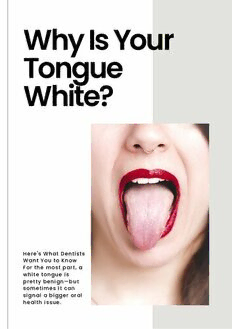
Why Is Your Tongue White eBook PDF
Preview Why Is Your Tongue White eBook
Why Is Your Tongue White? Here's What Dentists Want You to Know For the most part, a white tongue is pretty benign—but sometimes it can signal a bigger oral health issue. INTRO Unless you've just eaten a blue raspberry Jolly Rancher, your tongue has a pretty steady appearance: Pink, with a thin whitish coating, and devoid of any cracks or ulcerations. In a healthy tongue, you may also see tiny bumps on top of it that make it look rough —those are known as papillae, and contain tastebuds and temperature sensors. But sometimes, tongues can look a little different than expected—like, if it has a whiter-than-usual appearance—and it could signal a larger issue at hand. For the most part, your tongue can look white for totally benign reasons (maybe you're dehydrated or you skipped a few brushings), but thicker white patches can also be a sign of infection or, in rare cases, mouth or oral cancer. Here, oral health experts weigh in on what a "white tongue" can mean—and when you should book an appointment with your dentist. why is my tongue white , Playful teenage girl sticking out tongue while standing in studio is.gd/teethwhiten Beautiful smile in only 16 minutes A teeth whitening kit contains all the products you will need to achieve professional results at home. WHAT IS A "WHITE TONGUE," EXACTLY? Not all white tongues look exactly the same. Sometimes a white tongue can look like a thick, white coating on your tongue that stays put even after brushing; other times, it can form a thin lace- like pattern. The whiteness can cover your entire tongue, only the back of your tongue, or it can appear in patches, bumps, or specks. When your tongue has a distinct white appearance, you may also notice other oral symptoms: According to the Cleveland Clinic, your white tongue could be accompanied by a bad taste in your mouth, bad breath, or some redness. Bad breath or bad taste are commonly associated with a white tongue because of the raised papillae, per the Cleveland Clinic—those raised patches create a larger surface area for food, plaque, and bacteria to build up in your mouth, leading to the less-than-pleasant symptoms. WHAT TYPICALLY CAUSES A WHITE TONGUE? Just like all white tongues don't look exactly the same, white tongues aren't always caused by the same thing, either. "There are a variety of reasons why you may have white lesions on your tongue, and they can range from something fairly benign and common to more serious and potentially dangerous," Michael Nguyen, DDS, a board-certified periodontist with Mid-Peninsula Dental Specialists in Los Altos, California, tells Health. For the most part, a white tongue occurs when bacteria, food, and dead skin cells get trapped between the papillae on your tongue's surface. That causes those papillae—normally small and string-like—to swell up, causing a white appearance on your tongue. Sometimes, those papillae can grow large enough to give off a brown or blackish appearance, according to Brigham and Woman's Hospital's Division of Oral Medicine and Dentistry. That buildup on the tongue, per Brigham and Women's, is largely asymptomatic (aside from the white appearance) and can be remedied through oral health and dietary interventions (like drinking more water or cutting back on caffeine). But there could be other causes behind a white tongue as well. Here are six more reasons your tongue could have a whitish appearance—and how best to remedy each one. NT eAe t h TURAL WHITEN It lasts up to 15 years. Affordable and good quality is.gd/teethwhiten TONGUE INJURY "It's common to bite or burn your tongue which can be painful and result in white tissue," Amanda Lewis, DDS, a board-certified dentist based in Dallas, tells Health. You might also notice white tissue surrounding a recent tongue piercing. A "geographic tongue," meaning a tongue with glossy, red patches with white or light borders around the edges, is a normal part of healing as your tongue regrows tastebuds. Generally, a tongue injury will heal within a week and a half. Just avoid irritating substances like hot, spicy, or acidic foods and drinks to support the process. If you've recently gotten your tongue pierced, an antifungal mouthwash like Nystatin (like Nystop®) could also help combat bacterial growth in the area, per the Cleveland Clinic. LEUKOPLAKIA "Leukoplakia is a condition where thick, white patches appear on the tongue," Sharon Huang, DDS, a cosmetic dentist and founder of Les Belles NYC, a dentistry practice in Manhattan, tells Health. But the difference between these white patches and others are that they cannot be rubbed off or diagnosed as another condition or disease, according to the Academy of Oral and Maxillofacial Pathology (AOMP). It's important to diagnose and treat leukoplakia in a timely manner—per the AOMP, over time, a percentage of the lesions can transform into oral cancer. To diagnose leukoplakia, an oral surgeon will biopsy the white growth to look for its potential to become cancerous. Changes seen in the biopsy under a microscope can determine if the leukoplakia is "epithelial atypia" or "epithelial dysplasia"—the latter of which is ranked as mild, moderate, or severe.
